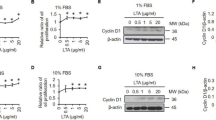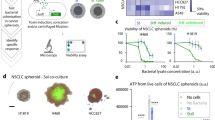Summary
High-risk, relapsed and refractory neuroblastoma are associated with poor 5-years survival rates, demonstrating the need for investigational therapeutic agents to treat this disease. Taurolidine is derived from the aminosulfoacid taurine and has known anti-microbial and anti-inflammatory properties. Taurolidine has also demonstrated anti-neoplastic effects in a range of cancers, providing the rationale to investigate the activity of taurolidine against neuroblastoma in preclinical studies. We investigated the in vitro activity of taurolidine against neuroblastoma using the alamar blue cytotoxicity assay, phase-contrast light microscopy, western blotting and analysis of global gene expression by RNA-Seq. In vivo activity of taurolidine was evaluated using mouse xenograft models. In vitro pre-clinical data show that taurolidine is cytotoxic to neuroblastoma cell lines, inducing cell death by apoptosis. Analysis of global gene expression and determination of signaling pathway activation scores using the in silico Pathway Activation Network Decomposition Analysis (iPANDA) platform indicates that taurolidine has an effect on the Notch, mitogen-activated protein kinase (MAPK) and interleukin-10 (IL-10) signaling pathways. In vivo experiments in xenograft mouse models show that taurolidine decreases tumor growth and improves survival. These results provide supportive pre-clinical data on the activity of taurolidine against neuroblastoma. The findings support the rationale for further evaluation of taurolidine for the treatment of relapsed/refractory neuroblastoma patients in an early phase clinical trial.





Similar content being viewed by others
References
Moreno L, Caron H, Geoerger B, Eggert A, Schleiermacher G, Brock P, Valteau-Couanet D, Chesler L, Schulte JH, De Preter K, Molenaar J, Schramm A, Eilers M, Van Maerken T, Johnsen JI, Garrett M, George SL, Tweddle DA, Kogner P, Berthold F, Koster J, Barone G, Tucker ER, Marshall L, Herold R, Sterba J, Norga K, Vassal G, Pearson AD (2017) Accelerating drug development for neuroblastoma - new drug development strategy: an innovative therapies for children with Cancer, European network for Cancer research in children and adolescents and International Society of Paediatric Oncology Europe Neuroblastoma project. Expert Opin Drug Discovery 12(8):801–811. https://doi.org/10.1080/17460441.2017.1340269
Park JR, Bagatell R, London WB, Maris JM, Cohn SL, Mattay KK, Hogarty M (2013) Children's oncology Group's 2013 blueprint for research: neuroblastoma. Pediatr Blood Cancer 60(6):985–993. https://doi.org/10.1002/pbc.24433
Jacobi CA, Menenakos C, Braumann C (2005) Taurolidine--a new drug with anti-tumor and anti-angiogenic effects. Anti-Cancer Drugs 16(9):917–921
Redmond HP, Neary PM, Jinih M, O'Connell E, Foley N, Pfirrmann RW, Wang JH, O'Leary DP (2018) RandomiSed clinical trial assessing use of an anti-inflammatoRy aGent in attenUating peri-operatiVe inflAmmatioN in non-meTastatic colon cancer - the S.U.R.G.U.V.a.N.T. trial. BMC Cancer 18(1):794. https://doi.org/10.1186/s12885-018-4641-x
Winnicki W, Herkner H, Lorenz M, Handisurya A, Kikić Ž, Bielesz B, Schairer B, Reiter T, Eskandary F, Sunder-Plassmann G, Sengoelge G (2018) Taurolidine-based catheter lock regimen significantly reduces overall costs, infection, and dysfunction rates of tunneled hemodialysis catheters. Kidney Int 93(3):753–760. https://doi.org/10.1016/j.kint.2017.06.026
Neary PM, Hallihan P, Wang JH, Pfirrmann RW, Bouchier-Hayes DJ, Redmond HP (2010) The evolving role of taurolidine in cancer therapy. Ann Surg Oncol 17(4):1135–1143. https://doi.org/10.1245/s10434-009-0867-9
Rodak R, Kubota H, Ishihara H, Eugster HP, Konu D, Mohler H, Yonekawa Y, Frei K (2005) Induction of reactive oxygen intermediates-dependent programmed cell death in human malignant ex vivo glioma cells and inhibition of the vascular endothelial growth factor production by taurolidine. J Neurosurg 102(6):1055–1068. https://doi.org/10.3171/jns.2005.102.6.1055
Calabresi P, Goulette FA, Darnowski JW (2001) Taurolidine: cytotoxic and mechanistic evaluation of a novel antineoplastic agent. Cancer Res 61(18):6816–6821
Chromik AM, Daigeler A, Bulut D, Flier A, May C, Harati K, Roschinsky J, Sülberg D, Ritter PR, Mittelkötter U, Hahn SA, Uhl W (2010) Comparative analysis of cell death induction by Taurolidine in different malignant human cancer cell lines. J Exp Clin Cancer Res 29(1):21–21. https://doi.org/10.1186/1756-9966-29-21
Chromik AM, Daigeler A, Hilgert C, Bulut D, Geisler A, Liu V, Otte JM, Uhl W, Mittelkotter U (2007) Synergistic effects in apoptosis induction by taurolidine and TRAIL in HCT-15 colon carcinoma cells. J Investig Surg 20(6):339–348. https://doi.org/10.1080/08941930701772157
Daigeler A, Brenzel C, Bulut D, Geisler A, Hilgert C, Lehnhardt M, Steinau HU, Flier A, Steinstraesser L, Klein-Hitpass L, Mittelkotter U, Uhl W, Chromik AM (2008) TRAIL and Taurolidine induce apoptosis and decrease proliferation in human fibrosarcoma. J Exp Clin Cancer Res 27:82. https://doi.org/10.1186/1756-9966-27-82
Abramjuk C, Bueschges M, Schnorr J, Jung K, Staack A, Lein M (2009) Divergent effects of taurolidine as potential anti-neoplastic agent: inhibition of bladder carcinoma cells in vitro and promotion of bladder tumor in vivo. Oncol Rep 22(2):409–414
Aceto N, Bertino P, Barbone D, Tassi G, Manzo L, Porta C, Mutti L, Gaudino G (2009) Taurolidine and oxidative stress: a rationale for local treatment of mesothelioma. Eur Respir J 34(6):1399–1407. https://doi.org/10.1183/09031936.00102308
Stendel R, Biefer HR, Dekany GM, Kubota H, Munz C, Wang S, Mohler H, Yonekawa Y, Frei K (2009) The antibacterial substance taurolidine exhibits anti-neoplastic action based on a mixed type of programmed cell death. Autophagy 5(2):194–210
Darnowski JW, Goulette FA, Cousens LP, Chatterjee D, Calabresi P (2004) Mechanistic and antineoplastic evaluation of taurolidine in the DU145 model of human prostate cancer. Cancer Chemother Pharmacol 54(3):249–258. https://doi.org/10.1007/s00280-004-0806-1
Li F, Qi J, Qin C, Fu Z, Ren W (2018) Taurolidine promotes cell apoptosis by enhancing GRIM19 expression in liver cancer. Oncol Rep 40(6):3743–3751. https://doi.org/10.3892/or.2018.6711
Walters DK, Muff R, Langsam B, Gruber P, Born W, Fuchs B (2007) Taurolidine: a novel anti-neoplastic agent induces apoptosis of osteosarcoma cell lines. Investig New Drugs 25(4):305–312. https://doi.org/10.1007/s10637-007-9052-9
Luckert C, Eschenburg G, Roth B, Appl B, Reinshagen K, Bergholz R (2014) Taurolidine specifically inhibits growth of neuroblastoma cell lines in vitro. J Pediatr Hematol Oncol 36(4):e219–e223. https://doi.org/10.1097/mph.0000000000000149
Eschenburg G, Luckert C, Reinshagen K, Bergholz R (2014) Taurolidine cooperates with antineoplastic drugs in neuroblastoma cells. Genes Cancer 5(11–12):460–469. https://doi.org/10.18632/genesandcancer.36
Karlisch C, Harati K, Chromik AM, Bulut D, Klein-Hitpass L, Goertz O, Hirsch T, Lehnhardt M, Uhl W, Daigeler A (2013) Effects of TRAIL and taurolidine on apoptosis and proliferation in human rhabdomyosarcoma, leiomyosarcoma and epithelioid cell sarcoma. Int J Oncol 42(3):945–956. https://doi.org/10.3892/ijo.2013.1772
Jayanthan A, Ruan Y, Truong TH, Narendran A (2014) Aurora kinases as druggable targets in pediatric leukemia: heterogeneity in target modulation activities and cytotoxicity by diverse novel therapeutic agents. PLoS One 9(7):e102741. https://doi.org/10.1371/journal.pone.0102741
Ozerov IV, Lezhnina KV, Izumchenko E, Artemov AV, Medintsev S, Vanhaelen Q, Aliper A, Vijg J, Osipov AN, Labat I, West MD, Buzdin A, Cantor CR, Nikolsky Y, Borisov N, Irincheeva I, Khokhlovich E, Sidransky D, Camargo ML, Zhavoronkov A (2016) In silico pathway activation network decomposition analysis (iPANDA) as a method for biomarker development. Nat Commun 7:13427. https://doi.org/10.1038/ncomms13427
Lun X, Ruan Y, Jayanthan A, Liu DJ, Singh A, Trippett T, Bell J, Forsyth P, Johnston RN, Narendran A (2013) Double-deleted vaccinia virus in virotherapy for refractory and metastatic pediatric solid tumors. Mol Oncol 7(5):944–954. https://doi.org/10.1016/j.molonc.2013.05.004
Zage PE, Nolo R, Fang W, Stewart J, Garcia-Manero G, Zweidler-McKay PA (2012) Notch pathway activation induces neuroblastoma tumor cell growth arrest. Pediatr Blood Cancer 58(5):682–689. https://doi.org/10.1002/pbc.23202
Son Y, Cheong Y-K, Kim N-H, Chung H-T, Kang DG, Pae H-O (2011) Mitogen-activated protein kinases and reactive oxygen species: how can ROS activate MAPK pathways? J Signal Transduction 2011:792639–792639. https://doi.org/10.1155/2011/792639
Son Y, Kim S, Chung HT, Pae HO (2013) Reactive oxygen species in the activation of MAP kinases. Methods Enzymol 528:27–48. https://doi.org/10.1016/b978-0-12-405881-1.00002-1
Verma R, Balakrishnan L, Sharma K, Khan AA, Advani J, Gowda H, Tripathy SP, Suar M, Pandey A, Gandotra S, Prasad TSK, Shankar S (2016) A network map of Interleukin-10 signaling pathway. J Cell Commun Signal 10(1):61–67. https://doi.org/10.1007/s12079-015-0302-x
Yan S, Li Z, Thiele CJ (2013) Inhibition of STAT3 with orally active JAK inhibitor, AZD1480, decreases tumor growth in neuroblastoma and pediatric sarcomas in vitro and in vivo. Oncotarget 4(3):433–445. https://doi.org/10.18632/oncotarget.930
Chromik AM, Hahn SA, Daigeler A, Flier A, Bulut D, May C, Harati K, Roschinsky J, Sulberg D, Weyhe D, Mittelkotter U, Uhl W (2010) Gene expression analysis of cell death induction by taurolidine in different malignant cell lines. BMC Cancer 10:595. https://doi.org/10.1186/1471-2407-10-595
Nici L, Monfils B, Calabresi P (2004) The effects of taurolidine, a novel antineoplastic agent, on human malignant mesothelioma. Clin Cancer Res 10(22):7655–7661. https://doi.org/10.1158/1078-0432.Ccr-0196-03
Stendel R, Picht T, Schilling A, Heidenreich J, Loddenkemper C, Janisch W, Brock M (2004) Treatment of glioblastoma with intravenous taurolidine. First clinical experience. Anticancer Res 24(2c):1143–1147
Stendel R, Scheurer L, Schlatterer K, Stalder U, Pfirrmann RW, Fiss I, Mohler H, Bigler L (2007) Pharmacokinetics of taurolidine following repeated intravenous infusions measured by HPLC-ESI-MS/MS of the derivatives taurultame and taurinamide in glioblastoma patients. Clin Pharmacokinet 46(6):513–524. https://doi.org/10.2165/00003088-200746060-00005
O'Brien GC, Cahill RA, Bouchier-Hayes DJ, Redmond HP (2006) Co-immunotherapy with interleukin-2 and taurolidine for progressive metastatic melanoma. Ir J Med Sci 175(1):10–14
Imhof L, Goldinger SM, Baumann K, Schad K, French LE, Rothlisberger P, Dummer R (2011) The antibacterial substance, taurolidine in the second/third-line treatment of very advanced stage IV melanoma including brain metastases: results of a phase 2, open-label study. Melanoma Res 21(1):80–83. https://doi.org/10.1097/CMR.0b013e328341442d
Braumann C, Gutt CN, Scheele J, Menenakos C, Willems W, Mueller JM, Jacobi CA (2009) Taurolidine reduces the tumor stimulating cytokine interleukin-1beta in patients with resectable gastrointestinal cancer: a multicentre prospective randomized trial. World J Surg Oncol 7:32. https://doi.org/10.1186/1477-7819-7-32
Braumann C, Winkler G, Rogalla P, Menenakos C, Jacobi CA (2006) Prevention of disease progression in a patient with a gastric cancer-re-recurrence. Outcome after intravenous treatment with the novel antineoplastic agent taurolidine. Report of a case. World J Surg Oncol 4:34. https://doi.org/10.1186/1477-7819-4-34
Gong L, Greenberg HE, Perhach JL, Waldman SA, Kraft WK (2007) The pharmacokinetics of taurolidine metabolites in healthy volunteers. J Clin Pharmacol 47(6):697–703. https://doi.org/10.1177/0091270007299929
Koldehoff M, Zakrzewski JL (2004) Taurolidine is effective in the treatment of central venous catheter-related bloodstream infections in cancer patients. Int J Antimicrob Agents 24(5):491–495. https://doi.org/10.1016/j.ijantimicag.2004.06.006
Simon A, Ammann RA, Wiszniewsky G, Bode U, Fleischhack G, Besuden MM (2008) Taurolidine-citrate lock solution (TauroLock) significantly reduces CVAD-associated grampositive infections in pediatric cancer patients. BMC Infect Dis 8:102. https://doi.org/10.1186/1471-2334-8-102
Sun BS, Wang JH, Liu LL, Gong SL, Redmond HP (2007) Taurolidine induces apoptosis of murine melanoma cells in vitro and in vivo by modulation of the Bcl-2 family proteins. J Surg Oncol 96(3):241–248. https://doi.org/10.1002/jso.20827
Harati K, Emmelmann S, Behr B, Goertz O, Hirsch T, Kapalschinski N, Kolbenschlag J, Stricker I, Tannapfel A, Lehnhardt M, Daigeler A (2016) Evaluation of the safety and efficacy of TRAIL and taurolidine use on human fibrosarcoma xenografts in vivo. Oncol Lett 11(3):1955–1961. https://doi.org/10.3892/ol.2016.4118
Arlt MJ, Walters DK, Banke IJ, Steinmann P, Puskas GJ, Bertz J, Rentsch KM, Ehrensperger F, Born W, Fuchs B (2012) The antineoplastic antibiotic taurolidine promotes lung and liver metastasis in two syngeneic osteosarcoma mouse models and exhibits severe liver toxicity. Int J Cancer 131(5):E804–E812. https://doi.org/10.1002/ijc.27378
Acknowledgments
This research was supported by the POETIC Foundation (grant number 10014557) and CorMedix Inc. (grant number 10017362). We thank the Charbonneau Microscope Facility (University of Calgary) for support with phase-contrast microscopy.
Funding
This research was supported by the POETIC Foundation (grant number 10014557) and CorMedix Inc. (grant number 10017362).
Author information
Authors and Affiliations
Corresponding author
Ethics declarations
Conflict of interest
L. Swift declares that she has no conflict of interest. C. Zhang declares that she has no conflict of interest. O. Kovalchuk declares that she has no conflict of interest. J. Boklan declares that she has no conflict of interest. T. Trippett declares that she has no conflict of interest. A. Narendran declares that he has no conflict of interest.
Ethical approval
All applicable international, national, and institutional guidelines for the care and use of animals were followed. All protocols were reviewed and approved by the Animal Care Committee of the University of Calgary (Protocol approval number: AC16–0243). This article does not contain any studies with human participants performed by any of the authors.
Informed consent
For this type of study, formal consent is not required.
Additional information
Publisher’s note
Springer Nature remains neutral with regard to jurisdictional claims in published maps and institutional affiliations.
Rights and permissions
About this article
Cite this article
Swift, L., Zhang, C., Kovalchuk, O. et al. Dual functionality of the antimicrobial agent taurolidine which demonstrates effective anti-tumor properties in pediatric neuroblastoma. Invest New Drugs 38, 690–699 (2020). https://doi.org/10.1007/s10637-019-00816-1
Received:
Accepted:
Published:
Issue Date:
DOI: https://doi.org/10.1007/s10637-019-00816-1




